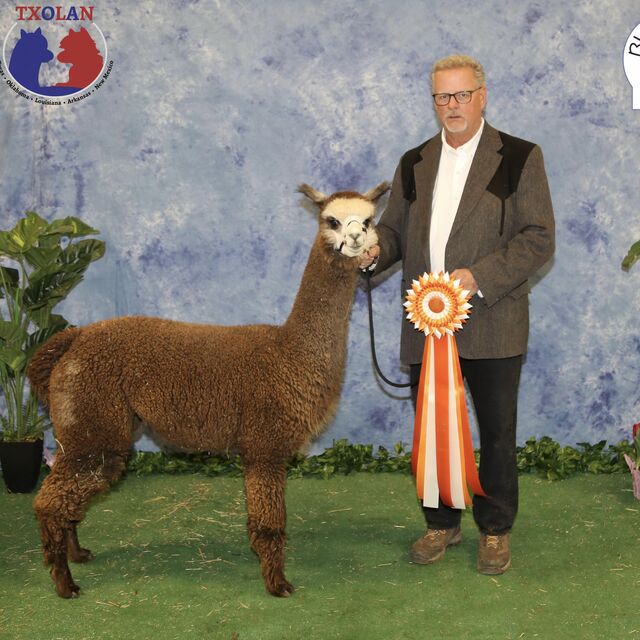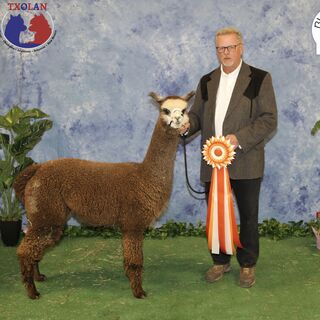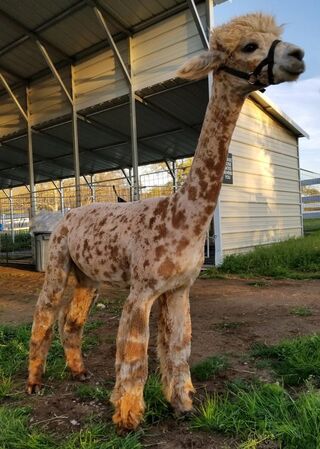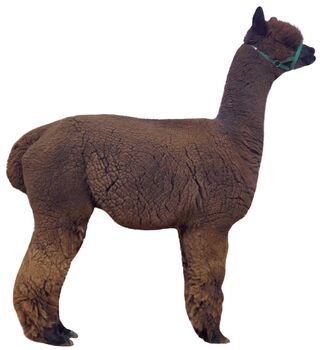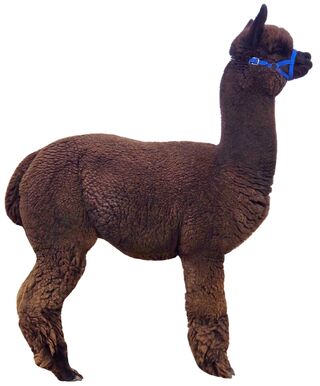IMPORTANT PURCHASING TIPS
IMPORTANT PURCHASING TIPS
AT LEAST 3 girls or 3 boys are needed, and preferably 4-5 (the very least 2). There can be exceptions but not on a long-term basis. You must pen males (intact and gelded) and females separately. They are prey animals and sleep in a rotational basis. That’s hard with only 2-3. Two Alpacas may end up fighting all the time, especially if they are males.
Alpacas as Pets… Are They Really?
There have been endearing and cute videos circulating recently (with several going viral) that show a single Alpaca living alone with a family of people or being led on a leash and treated as a pet dog. The animal is cute and playful, and the footage is endearing to those who do not understand normal alpaca behavior.
Because the videos are being shared on large platforms and accounts where millions of people are seeing and sharing, the public is being misinformed about what responsible alpaca ownership and normal alpaca behavior look like. This has resulted in an increased number of folks looking to purchase a single Alpaca and keep it as a pet, without understanding the needs of the Alpaca or what this baby will be growing up into.
Over-socialization Issues
Once a person or a family finds a source that will supply them with a single young animal, they then try to meet the physical needs of the animal, but they are not meeting the animal’s social and emotional needs. Given the opportunity and encouragement, a young Alpaca will be dutiful companions and playmates for several years. But it comes at a tremendous cost. The long-term health of the Alpaca is being placed at risk. Further, what many people do not realize is that given the way the animal has been imprinted, it will likely become a behavioral nightmare in a year or two.
Alpacas who are over-socialized with people when they are young grow up without boundaries and believe that humans are part of the larger Alpaca herd. They do not learn that people are not Alpacas. Sadly, the situation is likely to end with the animal being euthanized as it will become sexually mature and too dangerous for people to care for.
Castrating a male when they are young has been suggested as a modification technique; however, this has not been shown to be 100% effective. It is even less effective when they are mature and acting uncontrollably.
This is a link to a brief Wikipedia article on this subject, also known as Aberrant Behavior Syndrome: https://en.m.wikipedia.org/wiki/Berserk_llama_syndrome
Wherever They Are, They Are Livestock
Please understand that Alpacas are not pets like dogs. While they are a domesticated species, they were not bred to be companion animals in that same sense. You may call them your pets and enjoy having them, but there should always be an understanding that they should not relate to you as you do a dog.
They are livestock and were originally domesticated to provide clothing and food source for their shepherds and their families.
They also need herd mates of their own species. While they might buddy up to another animal, that poor substitute can never be the best solution for them. While they might appear to be cuddly animals, Alpacas have personal space issues, and many do not wish to be touched. Raising an Alpaca to be with humans first is an act of animal cruelty.
Do the Right Thing!
If you encounter such solo Alpaca postings, please try to educate whoever shared it. You May make someone mad. We have. But it is important to dissuade people from spreading wrong information. Especially, please do not share it again.
We can and should do this for the benefit of Alpacas everywhere.
What We Do and Why
Consequently, we do not sell nursing babies (crias) unless they are sold with their dam in a herd purchase, orphans that are being bottle fed unless with a herd purchase to a responsible owner who understands the proper way to bottle feed, We rarely sell them as juveniles (6-12 months old) by themselves. We will package a juvenile with a strong group of support alpacas allowing the juvenile to succeed. We hold to this belief that all responsible owners and breeders will follow these same guidelines.
Please do not purchase or sell Alpacas without ensuring they will be living in a group or herd and be well cared for by folks educated in the care and needs of these awesome animals. Alpacas thrive in groups or herds and deteriorate living as a single Alpaca or as a long-term pair. When solo Alpacas mature, they can develop aggressive sexual behaviors toward humans as they have been raised to see them as other Alpacas.
When and How to Purchase
Don’t be in a hurry to purchase, get 3 mentors and ask all 3 the same question. Take the best answer that fits your ranch. We jumped in with both feet and in our first year obtained our 3 mentors. Not everyone is built that way go at your pace. You can take time studying, researching, preparing, and building before buying your first Alpacas.
Don’t be bullied into a purchase or fall for a “this price is only good today” presentation. A pregnant Dam that has yet to be delivered can have one price that is different before and after delivery.
Touch animals and spend time with them before you purchase them. If the ranch offers educational tours, volunteer to come scoop poop at the ranch where you are considering your purchase. Do this more than once. That way you can spend plenty of time with them. Be wary of a ranch that has so many Alpacas that they fail to appropriately socialize your potential purchases. You don’t want a “lap Alpaca”, but Alpacas that are extremely hesitant to trust your presence without constantly fleeing are not an enjoyable purchase.
Ask questions when you visit ranches. Expect good answers. The page that you are reading now is a result of answering a lot of the same questions repeatedly.
What to Look For
We often describe Alpacas personalities as being like cats. They come and go of their own accord. Some will be more curious than others. Some will even venture a nose kiss. Others may not appreciate a touch but are a wonderful animal on a lead, and some are smarter than others. Just as cats range from lap cats to feral cats and everything in between, you will find each Alpaca has its own distinct and engaging personality.
In addition to an Alpaca’s personality, you will want to closely examine your potential Alpacas for good physical and fiber traits. Expect to pay more for a better animal! An animal that has all the following will and should cost more!
Here are 40-some things to look at:
• Soft, fine fiber that has a good “handle.”
• Good density to the fiber without mistaking coarseness for density
• A good staple length to the fiber, considering the shearing date, the Alpaca’s age, and reproductive status.
• Good and consistent fiber across the blanket
• Lack of guard hair in the blanket
• Preferred fiber exhibits good character/crimp in the show ring but not as critical for the fiber mill.
• Fiber that has independent fiber characteristics (structure), also called lock style in a Suri—similar but breed specific in concept, akin to the stands of a shag rug.
• In a Huacaya fiber that should shine with brightness next to the skin, or have luster on a Suri (the most important Suri trait) • Uniformity of the above fiber characteristics including color in Greys/Indefinites/Multis
• Strong, solid bone substance relative to age; thin bones are not as desirable trait.
• A flat topline along their spine; touch it to be sure as fiber can hide it.
• A nice large animal means more fiber, but smaller animals are easier to handle.
• Good balance/proportionality: The length of the neck and legs should be 2/3 of the length of the back.
• The neck should be within a 90° to 100° angle.
• Front legs that are straight especially in the lower bones without being bow legged or skewed out.
• Upright pasterns (ankles) that are not collapsed and sitting on the ground.
• Rear legs should be straight and should not move independently and without tracking side-to-side or in a bow legged motion.
• When looking at the body it should be a good breadth and depth in front and broad and well-muscled in the hind quarters
• A good gait without any noticeable walking problems
• Clear eyes without drainage
• Healthy ears without any smell or drainage
• Lower teeth must meet the forward edge of the upper dental pad.
• Fighting teeth should be blunted.
• Molars should feel that they are in good condition; they’re impossible to see.
• A straight neck when viewed from the front.
• A straight tail without kinks—feel of it!
• A “typey” head with a shorter muzzle is preferred by many today.
• Ears that are an appropriate length, erect and spear-shaped, not banana-shaped like a llama
• And a nice-looking top knot just makes them prettier to look at.
• A clear, bright expression that is attentive and curious, without fear in their eyes.
• Males must have two descended testicles if age 6 months or more and be solid and firm.
• Female genitalia should be normal in appearance and size.
• Advanced considerations, especially when buying for show, might include:
• fiber histograms
• EPD’s
• skin biopsies
• registration certificates
• past show winnings
• pedigree, i.e., bloodline
• progeny, i.e., offspring
• brothers/sisters show performance.
• and other factors.
All these aspects are examined in great depth in the text, “The Art & Science of Alpaca Judging”. The text is published and available from the Alpaca Owners Association. It is replete with photos and illustrations.
Check Their Body Score
Alpacas are a naturally lean animal. Over feeding them can result in an obese animal. But some animals are predisposed to eating free choice hay all day long thereby making themselves fat. An animal that has a body score of 5 on a 1 to 9/10 scale is the goal. But Alpacas that are not ideal can and should still be considered. 4-6 is acceptable in the show ring.
Ensure that Alpacas get 1.5-2% (approx.) of their body weight in hay, feed supplements and grazing daily. This is somewhat easier to determine in a small herd. Therefore, problems with a less than ideal body score can be addressed and frequently well managed.
The Most Popular Question
“How much does an Alpaca cost?” The honest answer is, “It depends.” We’re not trying to avoid the question. But you may find a decent Alpaca that needs to be rehomed for little or no cost. There are always people that are retiring or ending their Alpaca ranch due to medical or family considerations. You must be at the right place and at the right time to be this fortunate.
Male Alpacas, for the most part, are less expensive than females. The obvious reason is that females can make more crias. So, a male may easily run from $1000 to $3,000 and breeding males could be $3,000 to $100,000or depending upon the desires of the seller. Females many times can run from $1000 to $50,000. You must decide about how much your budget will allow.
Our mature males are kept away from females and in individual pens next to one another. They are more compact in their manure habits. Females, on the other hand, have a very deep seeded instinct to keep spreading out the manure pile so a male can tell by the smell of her urine that needs to be bred. This instinct is in full effect even if there is no male on the property!
ALPACAS AND OTHER ANIMAL: https://www.plumcreekalpacas.com/page/10272/alpacas-and-other-animals
Thank you for permissions to use this information. https://www.facebook.com/aubrey.oaks.alpacas
Friday, January 12, 2024

